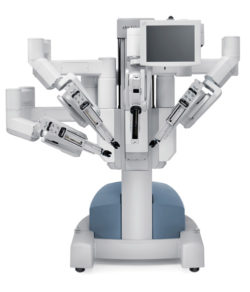Robotic Surgery
 The da Vinci Surgical System has made treating prostate conditions tremendously more effective and comfortable for men.
The da Vinci Surgical System has made treating prostate conditions tremendously more effective and comfortable for men.
In the treatment of prostate cancer, millimeters matter. Nerve fibers and blood vessels are attached to the prostate gland. To spare these nerves, they must be delicately and precisely separated from the prostate before its removal. Surgeons use the precision, vision and control provided by da Vinci to assist them in removing the cancerous prostate while preserving important nerves and blood vessels.
For localized prostate cancer, radical prostatectomy (removal of the prostate gland and some tissue around it) is considered the definitive way to treat the cancer. An estimated 91% of prostate cancer cases diagnosed in the U.S. are localized, which means many men are potential candidates for complete cancer removal.
With any cancer treatment, the first priority is survival. Several large studies suggest there is a greater chance of long-term survival for patients undergoing surgery over other potential treatments. Patients undergoing radical prostatectomy had 40% lower risk of death from prostate cancer than radiation patients 15 years after treatment (according to a study of 3,159 men adjusted for age at diagnosis, race, socioeconomic status, Gleason score, biopsy grade of tumor and year of diagnosis1).
1. Tewari A, Raman JD, Chang P, Rao S, Divine G, Menon M.Long-term survival probability in men with clinically localized prostate cancer treated either conservatively or with definitive treatment (radiotherapy or radical prostatectomy). Urology. 2006 Dec; 68(6):1268-74.
For Men
The da Vinci Surgical System has made treating prostate conditions tremendously more effective and comfortable for men.
In the treatment of prostate cancer, millimeters matter. Nerve fibers and blood vessels are attached to the prostate gland. To spare these nerves, they must be delicately and precisely separated from the prostate before its removal. Surgeons use the precision, vision and control provided by da Vinci to assist them in removing the cancerous prostate while preserving important nerves and blood vessels.
For localized prostate cancer, radical prostatectomy (removal of the prostate gland and some tissue around it) is considered the definitive way to treat the cancer. An estimated 91% of prostate cancer cases diagnosed in the U.S. are localized, which means many men are potential candidates for complete cancer removal.
With any cancer treatment, the first priority is survival. Several large studies suggest there is a greater chance of long-term survival for patients undergoing surgery over other potential treatments. Patients undergoing radical prostatectomy had 40% lower risk of death from prostate cancer than radiation patients 15 years after treatment (according to a study of 3,159 men adjusted for age at diagnosis, race, socioeconomic status, Gleason score, biopsy grade of tumor and year of diagnosis1).
1. Tewari A, Raman JD, Chang P, Rao S, Divine G, Menon M.Long-term survival probability in men with clinically localized prostate cancer treated either conservatively or with definitive treatment (radiotherapy or radical prostatectomy). Urology. 2006 Dec; 68(6):1268-74.
For Women
For women, laparoscopic and robotic operating techniques use smaller abdominal incisions, and specialized surgical instruments offer a minimally invasive approach to abdominal or pelvic surgery. The da Vinci robotic approach allows for minimally invasive treatment of female pelvic conditions and prolapsed of the female organs with less pain, scarring and discomfort than traditional methods.
Click on the providers’ images below to learn more about our Urology team.
Providers in this Specialty





